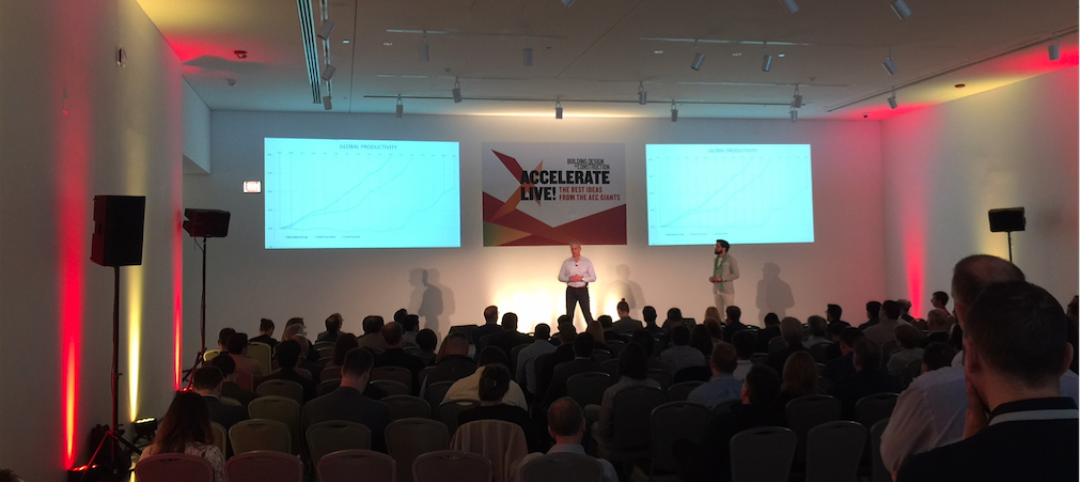Last month, I wrote about how automation and AI are dramatically changing all four fundamental relationships between buildings and machines. For example, nanotechnology, which manipulates individual atoms and molecules to assemble things, could make the modernist metaphor of a “machine for living in” into reality, since the building would actually be composed of many tiny machines.
In fact, that’s not quite accurate. The definition of “machine” is “an apparatus using or applying mechanical power and having several parts, each with a definite function and together performing a particular task.”
So machines are made of distinct parts, cobbled together to fulfill a function. They are characterized by their composition, as assemblages of singular bits and pieces in which the whole is greater than the sum.
SEE ALSO: Assessing AI's impact on the AEC profession and the built environment
But nanotech will completely change this. When entire buildings can be shaped from microscopic components, the visible distinction between the individual parts will evaporate. A structure built from invisible machines will not appear to be a machine at all, since it no longer will be perceived as an assembly of parts. An edifice made of congealed cybernetic butter will look to be all whole, no parts. The very concept of a “building” could become meaningless, since it will no longer be “built” in any traditional way.
Remember “Terminator 2”? Arnold Schwarzenegger’s T-800 is a machine: steel and servos wrapped in human skin. Robert Patrick’s T-1000 is made of liquid metal (“mimetic polyalloy”). He’s like sentient mercury, morphing into any shape he needs. A nanotech building (“nanotecture”?) would make conventional structures seem like Robby the Robot (of “Forbidden Planet” fame).
Buttery buildings could change everything we think and know about architecture. Frank Lloyd Wright felt that architectural form should stem from the inherent “nature” of its materials: “Each material speaks a language of its own.” In his mind, the proportions, heft, and texture of brick logically translated into structures such as the Robie House, which extends horizontally and hugs the land. But when the constituent parts of a building are too small to be seen with the naked eye, the relationships between form and materials will change. What is the “language” of a nanobot?
Because the character of a building could vary upon command—hard and opaque one minute, soft and transparent the next—the fabric of buildings could become fluid, fluctuating states from solid to liquid to gas and back. The notion of truth in materials will become irrelevant. In fact, the word material could go away. When the basic building blocks of architecture have no strict definition, structure and substance could separate. Matter may not matter.
Could there come a time when buildings will become less about bricks and mortar and feel more like mists or fogs, vaguely enveloping space in ways we can barely picture now? What will it be like to live in a cloud?
Lance Hosey, FAIA, LEED Fellow, is a Design Director with Gensler. His book, The Shape of Green: Aesthetics, Ecology, and Design, has been an Amazon #1 bestseller in the Sustainability & Green Design category.
Related Stories
Accelerate Live! | Jul 17, 2018
Call for speakers: Accelerate AEC! innovation conference, May 2019
This high-energy forum will deliver 20 game-changing business and technology innovations from the Giants of the AEC market.
Accelerate Live! | Jun 24, 2018
Watch all 19 Accelerate Live! talks on demand
BD+C’s second annual Accelerate Live! AEC innovation conference (May 10, 2018, Chicago) featured talks on AI for construction scheduling, regenerative design, the micro-buildings movement, post-occupancy evaluation, predictive visual data analytics, digital fabrication, and more. Take in all 19 talks on demand.
Sponsored | AEC Tech | Jun 15, 2018
4 project management mistakes to avoid at all costs
Helpful tips for managing projects more effectively
| Jun 11, 2018
Accelerate Live! talk: The smart jobsite — Predictive visual data analytics for proactive project controls
In this 15-minute talk at BD+C’s Accelerate Live! conference (May 10, 2018, Chicago), a trio of experts in predictive visual data analytics presents how design-build giant Clayco has leveraged this technology to achieve production efficiency on several construction sites.
| Jun 11, 2018
Accelerate Live! talk: Design innovation at Adrian Smith + Gordon Gill Architecture
In this 15-minute talk at BD+C’s Accelerate Live! conference (May 10, 2018, Chicago), AS+GG’s Anthony Viola takes us behind the magic curtain to illuminate the firm’s methods for nurturing design innovation.
| Jun 11, 2018
Accelerate Live! talk: ‘AEC can has Blockchains?’
In this 15-minute talk at BD+C’s Accelerate Live! conference (May 10, 2018, Chicago), HOK’s Greg Schleusner explores how the AEC industry could adapt the best ideas from other industries (banking, manufacturing, tech) to modernize inefficient design and construction processes.
| Jun 11, 2018
Accelerate Live! talk: How advanced digital fabrication techniques are driving design innovation
In this 15-minute talk at BD+C’s Accelerate Live! conference (May 10, 2018, Chicago), SOM’s Lucas Tryggestad and Kyle Vansice present the firm’s 3D-printed building project and explore how digital fabrication is pushing design innovation.
| May 30, 2018
Accelerate Live! talk: Seven technologies that restore glory to the master builder
In this 15-minute talk at BD+C’s Accelerate Live! conference (May 10, 2018, Chicago), AEC technophile Rohit Arora outlines emerging innovations that are poised to transform how we design and build structures in the near future.
| May 30, 2018
Accelerate Live! talk: Why the AEC industry must adapt to the Internet of Things boom
In this 15-minute talk at BD+C’s Accelerate Live! conference (May 10, 2018, Chicago), building systems expert Jeff Carpenter explores established and emerging IoT applications for commercial and institutional buildings, and offers a technology roadmap for navigating the IoT landscape.
| May 24, 2018
Accelerate Live! talk: The rise of multi-user virtual reality
In this 15-minute talk at BD+C’s Accelerate Live! conference (May 10, 2018, Chicago), two of CannonDesign's tech leaders present their early findings from pilot testing multi-user VR technology for AEC project coordination.










